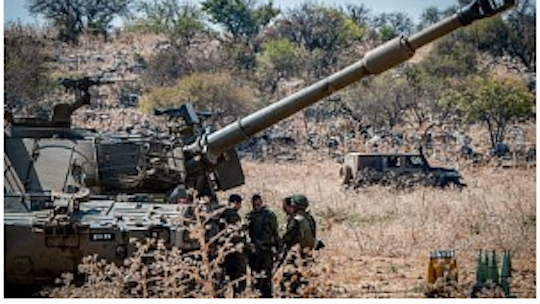Israel is enforcing its red lines in both Syria and Lebanon, but while it has so far been extremely successful on the tactical front, the strategic threat continues to exist.
BY YAAKOV LAPPIN
(September 2, 2019 / JNS) Hezbollah launched a dangerous attack on an Israel Defense Forces base in northern Israel on Sunday—an attack that could have resulted in a rapid deterioration into a larger conflict. Thanks to the IDF’s readiness, operational sophistication and intelligence capabilities, the attack was contained.
The IDF even employed a deception to fool Hezbollah into thinking it had caused casualties. It pretended to airlift wounded soldiers from the scene of the attack to a Haifa hospital. Dummies on stretchers, bandaged and “bleeding” heavily, were evacuated via helicopter. This show, apparently prepared in advance, caused Hezbollah to believe its attack was effective, ending the incident; hours passed before the IDF announced that there were actually no casualties.
By that time, the IDF had fired some 100 artillery shells at Hezbollah positions in southern Lebanon near the scene of the attack, as well as directing helicopter fire at multiple Hezbollah targets. It remains unclear at this time whether the Hezbollah cell that launched the attack—a volley of guided anti-tank missiles which struck an Israeli armored vehicle—was hit. Either way, the incident ended quickly.
Hezbollah leader Hassan Nasrallah wanted to strike at Israel and redeem his “credibility,” but not plunge Lebanon into a devastating war that would threaten the future of his organization.
Still, the root cause behind the heightened tensions remains very much in place.
On August 25, the IDF successfully prevented an attempt by an Iranian Quds Force-led squad to launch explosive drones from Syria into Israel. The Israel Air Force struck the drone squad in its headquarters southeast of Damascus, killing the operatives, including two Hezbollah members. Nasrallah vowed revenge for the attack. The fact that this so-called revenge would be carried out on behalf of two Hezbollah members killed while actively trying to launch explosive drones into Israel did not stop Nasrallah.
It appears likely that Iran instructed Hezbollah to act on its behalf, in an effort to deter Israel from taking further action to defend itself in the region. The drone squad was itself reportedly an attempt to exact “revenge” for alleged Israeli strikes that occurred last month, reportedly targeting new Iranian missile bases in Iraq.
The pattern is clear enough: Iran is trying to build military attack bases throughout the region and deter Israel from actively defending itself. Israel has no intention of being deterred and is using its military capabilities to prevent Iran from fulfilling its schemes.
Another source of tension behind Sunday’s incident is the alleged Israeli drone strike in Beirut, which also occurred on August 25 according to international media reports. This attack, according to the Times of London, destroyed a key component for producing high-grade propellant for guided ballistic missiles.
Nasrallah interpreted that incident as an Israeli violation of a tacit understanding that the Jewish state would not launch strikes on Lebanese soil. Yet Nasrallah failed to mention that Israel had repeatedly warned him it would not tolerate continued efforts to manufacture guided missiles in Lebanon.
In recent days, the IDF released revealing information about the precision missile program that has been unfolding on Lebanese soil.
According to this information, in 2016, Iran and Hezbollah, frustrated by failed efforts to set up precision missile factories in Syria, shifted their efforts to Lebanon. Their plan was to convert Hezbollah’s existing rockets into guided ones.
To achieve this, the Iranian axis began trying to smuggle precision missile components from Iran to Lebanon. It also transported ordinary rockets, produced in a Syrian weapons factory, to Lebanon. In line with the plan, Hezbollah built facilities across Lebanon to convert the rockets into guided missiles under the guidance of the Iranian Quds Force, which is headed by the notorious Iranian general Qassem Soleimani.
Iran smuggled weapons components via official Lebanese border crossings, civilian flights to Beirut’s Rafiq Hariri International Airport and by sea via the Port of Beirut. Yet Tehran and Hezbollah still failed to meet their goals. In recent months they doubled down on their efforts by broadening the construction of missile conversion sites in Lebanon.
Israel has identified Hezbollah’s guided missile project as a top priority threat which, if left unchecked, will give the Shi’ite terror army and its Iranian sponsor the ability to accurately strike strategic targets in Israel.
During a conference call with journalists, IDF’s spokesman Lt. Col Jonathan Conricus stated that Israel had “no intention” of allowing the Lebanese guided missile program to exist “because of the severity of the threat. This is the context from our point of view.”
In the same vein, Israel has no intention of allowing Iran and Hezbollah take over Syria and turn it into a second Lebanon. Minister Yoav Gallant, a member of Israel’s inner Security Cabinet, told Israel’s Channel 12 on Sunday evening that Israel cannot allow Iran to set up a new military front in Syria. Israel, he said, would not “repeat the mistake” it made with Hezbollah, allowing it to grow into a formidable, heavily armed Iranian agent on its doorstep.
Referring to Syria, Galant said, “When you catch them at the preparation stage, you don’t allow them to prepare and you sweep them aside. They can’t respond properly. We can’t allow a situation in which Iran threatens the Israeli home front, yet the Iranian home front 1,500 kilometers away is not threatened. We won’t repeat the mistake we made with the Lebanese front.”
As a result, Israel is enforcing its red lines. In Syria, that means preventing the rise of Iran’s war machine. In Lebanon, it means not accepting the growth of a guided missile production program.
“The bottom line is that Hezbollah executed the attack, however, it failed to cause casualties,” Conricus stated on Sunday. The tactical event, he added, is over, but the larger strategic situation “is ongoing.”
